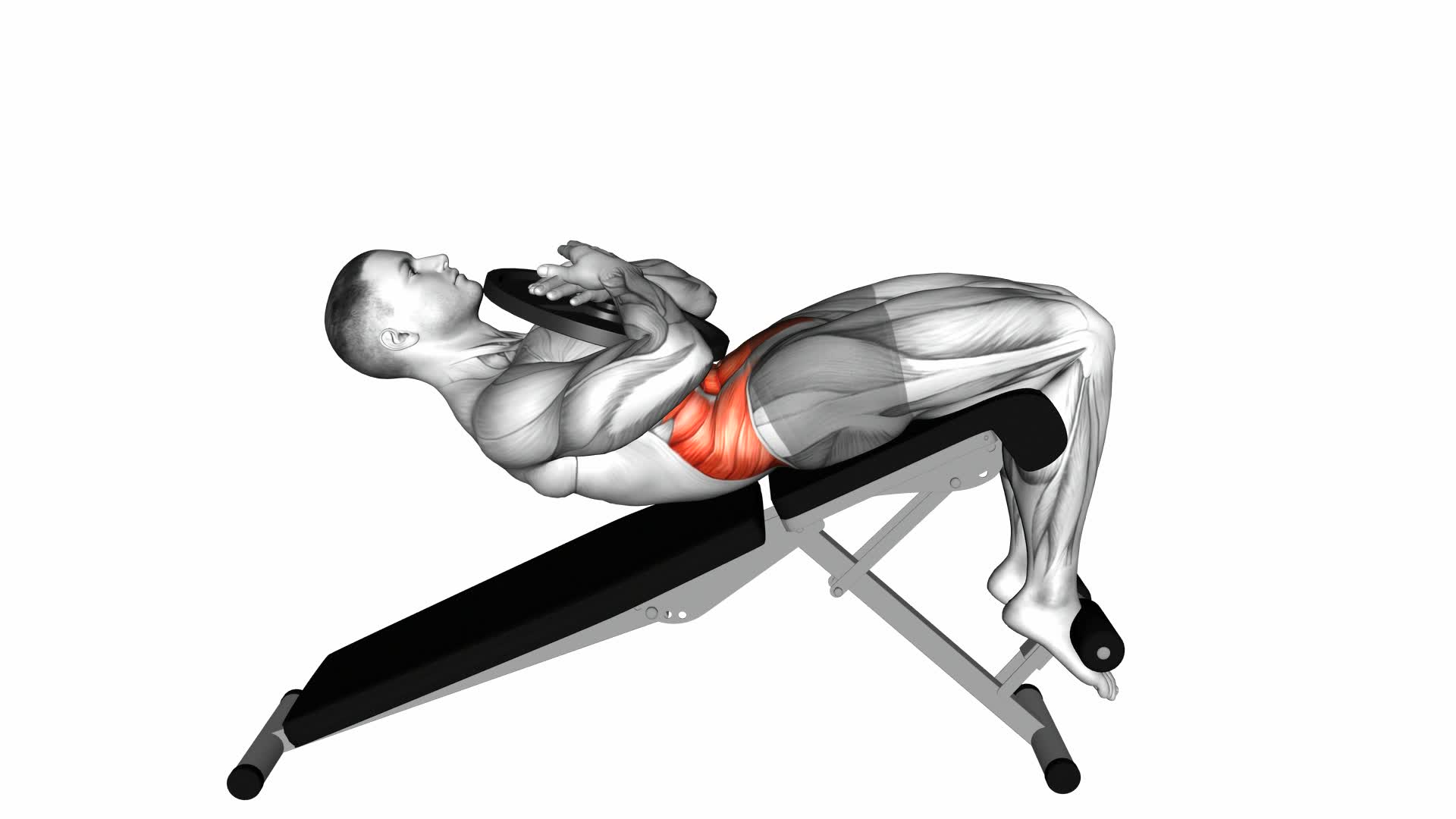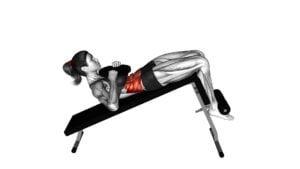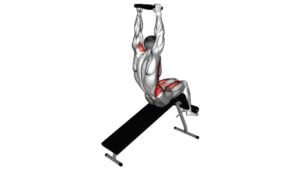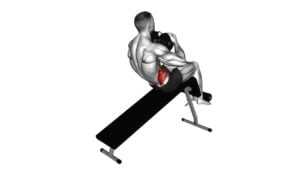Weighted Decline Crunch – Video Exercise Guide & Tips

Are you looking for a way to take your crunches to the next level? Look no further than the weighted decline crunch. This exercise targets your abs, giving you a more intense and effective workout.
Watch This Exercise Video
In this guide, we'll show you the proper form and technique, variations and progressions, and common mistakes to avoid.
Get ready to strengthen your core and see results with the weighted decline crunch. Let's dive in!
Key Takeaways
- Weighted decline crunches can increase core strength and target abdominal muscles.
- Incorporating cardio exercises into abdominal workouts can enhance results and improve cardiovascular health.
- Progressive overload in weighted decline crunches can stimulate muscle growth and prevent plateauing.
- Safety and comfort in weighted decline crunches can be achieved through proper form, controlled movement, and gradual progression.
Benefits of the Weighted Decline Crunch
You will experience increased core strength by incorporating the weighted decline crunch into your workout routine. This exercise specifically targets your abdominal muscles, helping to strengthen and tone them. By adding weights to the exercise, you're challenging your core even more, leading to greater gains in strength.
The weighted decline crunch is an effective way to engage your entire core, including your rectus abdominis, obliques, and transverse abdominis. These muscles are responsible for providing stability to your spine and pelvis, which is essential for overall body stability.
In addition to improved core strength, the weighted decline crunch also helps to improve your overall body stability. As you perform the exercise, you're required to maintain balance and control, which helps to strengthen the muscles that support your spine. This can lead to better posture and reduced risk of injuries in everyday activities.
To perform the weighted decline crunch, start by lying on a decline bench with your feet secured. Hold a weight plate or dumbbell against your chest and slowly curl your upper body towards your knees, engaging your core muscles. Pause for a moment at the top and then slowly lower back down to the starting position.
Incorporating the weighted decline crunch into your workout routine can be a beneficial way to increase your core strength and improve overall body stability.
Proper Form and Technique
To ensure proper execution of the weighted decline crunch, focus on maintaining a stable and controlled movement throughout the exercise. This will help you engage the targeted muscle groups effectively and minimize the risk of injury.
Here are some key tips to keep in mind:
- Position yourself correctly: Start by lying on a decline bench with your feet secured under the foot pads. Place a weight plate on your chest, holding it firmly with your hands crossed over it.
- Engage your core: Before you start the movement, engage your core by actively contracting your abdominal muscles. This will help stabilize your spine and prevent excessive arching.
- Control the movement: Slowly lift your upper body towards your knees while exhaling. Focus on using your abs to initiate and control the movement. Avoid using momentum or pulling with your neck or arms.
- Maintain proper form: As you lift your upper body, keep your lower back pressed against the bench and avoid rounding your shoulders. Pause briefly at the top of the movement, then slowly lower yourself back down while inhaling.
Common misconceptions about the weighted decline crunch include using excessive momentum, neglecting proper form, and relying solely on the neck and arms for the movement. By following these tips and maintaining proper form and technique, you can effectively target your abdominal muscles and achieve the best results from this exercise.
Variations and Progressions
Continuing the discussion from proper form and technique, let's explore different variations and progressions of the weighted decline crunch. As you become more advanced in your workouts, you may want to incorporate some advanced modifications to challenge your core muscles even further.
One option is to increase the weight you use during the exercise. You can hold a dumbbell, a medicine ball, or even a weighted plate against your chest as you perform the crunches. This added resistance will intensify the exercise and help you build stronger abdominal muscles.
Another way to progress the weighted decline crunch is by incorporating different equipment options. Instead of using a decline bench, you can try using a stability ball or an exercise ball. This will engage your core muscles in a different way and provide a greater challenge to your balance and stability. Additionally, you can try using resistance bands or cable machines to add resistance to the exercise.
By incorporating advanced modifications and different equipment options, you can continue to challenge your core muscles and make progress in your fitness journey.
Now that we've explored the variations and progressions of the weighted decline crunch, let's move on to the next section where we'll discuss common mistakes to avoid.
Common Mistakes to Avoid
As you progress in your weighted decline crunch workouts, it's important to be aware of common mistakes that can hinder your results. To ensure that you're performing the exercise correctly and maximizing its benefits, avoid the following common mistakes:
- Using momentum: One of the most common mistakes is using momentum to complete the movement. Instead, focus on using your abdominal muscles to lift your upper body and control the descent.
- Rounding your back: Another mistake is rounding your back during the crunch. This not only reduces the effectiveness of the exercise but also puts unnecessary strain on your spine. Keep your back flat against the bench throughout the movement.
- Placing your hands behind your head: Many people tend to place their hands behind their head and pull on it during the crunch. This can strain your neck and lead to discomfort. Instead, place your hands lightly on your chest or cross them over your chest.
- Lifting your hips off the bench: Avoid lifting your hips off the bench as you perform the crunch. This can shift the focus away from your abdominal muscles and onto your hip flexors.
By avoiding these common mistakes and focusing on proper technique, you can ensure that you're getting the most out of your weighted decline crunch workout.
Now, let's move on to the next section where we'll discuss some tips for maximizing your results.
Tips for Getting the Most Out of Your Workout
To maximize your results, incorporate these tips into your weighted decline crunch workout.
First, focus on maximizing efficiency by performing each repetition with proper form and control. Avoid rushing through the exercise and instead, concentrate on engaging your core muscles and feeling the contraction. This will ensure that you're effectively targeting your abs and getting the most out of each rep.
Additionally, consider incorporating cardio into your workout routine. While weighted decline crunches are great for strengthening and toning your abs, cardio exercises can help you burn calories and reduce overall body fat. This will help to reveal your toned abs and enhance the results of your workout. You can include activities such as running, cycling, or jumping rope for a few minutes before or after your weighted decline crunches.
Furthermore, make sure to challenge yourself by gradually increasing the weight or resistance used during your weighted decline crunches. This progressive overload will stimulate muscle growth and help you achieve your desired results faster. However, always remember to listen to your body and only increase the weight or resistance when you feel ready and comfortable.
Frequently Asked Questions
How Many Calories Can I Burn by Doing Weighted Decline Crunches?
By doing weighted decline crunches, you can burn a significant amount of calories. This exercise not only targets your abdominal muscles but also engages other muscle groups, increasing the overall calorie burn.
The added weight provides resistance, making the workout more challenging and effective. In addition to burning calories, weighted decline crunches help strengthen and tone your abs, improve core stability, and enhance your posture.
Incorporating this exercise into your routine can have numerous benefits for your fitness journey.
Can Weighted Decline Crunches Help in Reducing Belly Fat?
Weighted decline crunches are a great exercise for reducing belly fat. When done with proper form, they target the abdominal muscles, helping to strengthen and tone them.
The added weight increases the intensity, leading to greater calorie burn and potential fat loss.
Are Weighted Decline Crunches Suitable for Beginners?
Weighted decline crunches may not be suitable for beginners due to their higher intensity and the potential risk of injury. However, there are modifications you can make to make them more beginner-friendly, such as using lighter weights or performing the exercise without any added weight.
Alternatively, there are plenty of other core exercises that beginners can try, such as planks, bicycle crunches, or Russian twists, which can still help strengthen and tone the abdominal muscles.
Do I Need Any Special Equipment for Weighted Decline Crunches?
To perform weighted decline crunches, you'll need some special equipment. This exercise requires a decline bench, which allows you to position your body at an angle and work your abs more effectively.
Additionally, you'll need some weights to add resistance to the exercise.
The benefits of weighted decline crunches include strengthening your core muscles, improving your posture, and enhancing your overall stability.
How Often Should I Incorporate Weighted Decline Crunches Into My Workout Routine?
To maximize your workout routine, it's important to know how often to incorporate weighted decline crunches. Adding this exercise to an advanced routine can yield great benefits. By incorporating weighted resistance, you increase the intensity and challenge your abdominal muscles even more.
However, it's crucial to give your muscles time to recover. Aim to include weighted decline crunches 2-3 times a week, allowing for at least 48 hours of rest between each session.
Conclusion
In conclusion, the weighted decline crunch is an effective exercise for targeting and strengthening the abdominal muscles. By adding resistance, you can increase the intensity and challenge of the exercise.
It's important to maintain proper form and technique to avoid injury and maximize results. Additionally, there are variations and progressions that can be incorporated to keep your workouts challenging and prevent plateaus.
Remember to avoid common mistakes and follow these tips to get the most out of your workout.

Author
Years ago, the spark of my life’s passion ignited in my mind the moment I stepped into the local gym for the first time. The inaugural bead of perspiration, the initial endeavor, the very first surge of endorphins, and a sense of pride that washed over me post-workout marked the beginning of my deep-seated interest in strength sports, fitness, and sports nutrition. This very curiosity blossomed rapidly into a profound fascination, propelling me to earn a Master’s degree in Physical Education from the Academy of Physical Education in Krakow, followed by a Sports Manager diploma from the Jagiellonian University. My journey of growth led me to gain more specialized qualifications, such as being a certified personal trainer with a focus on sports dietetics, a lifeguard, and an instructor for wellness and corrective gymnastics. Theoretical knowledge paired seamlessly with practical experience, reinforcing my belief that the transformation of individuals under my guidance was also a reflection of my personal growth. This belief holds true even today. Each day, I strive to push the boundaries and explore new realms. These realms gently elevate me to greater heights. The unique combination of passion for my field and the continuous quest for growth fuels my drive to break new ground.







